Impact of Social Media Marketing on Consumer Behaviour: NEXT, UK
VerifiedAdded on 2022/09/23
|105
|23526
|64
Thesis and Dissertation
AI Summary
This dissertation investigates the impact of social media marketing on consumer behavior, focusing on a case study of NEXT in the UK. The research explores the relationship between social media marketing and consumer behavior, considering factors such as technology, platforms used, and purchase intentions. The study employs a mixed-methods approach, including a literature review, survey, and statistical analysis to examine the influence of social media marketing on consumer behavior. The findings reveal significant correlations between technology, platforms, purchase intentions and social media marketing, highlighting the importance of these factors in shaping consumer decisions. The dissertation also identifies challenges in using social media marketing and provides recommendations for future research and businesses aiming to enhance their marketing strategies. The study concludes by emphasizing the need for businesses to adapt their strategies to leverage the power of social media effectively, ultimately influencing consumer behavior and gaining a competitive advantage.

Running head: DISSERTATION
Impact of Social Media Marketing on Consumer Behaviour: A Case Study of NEXT, UK
Name of the Student:
Name of the University:
Author’s Note:
Impact of Social Media Marketing on Consumer Behaviour: A Case Study of NEXT, UK
Name of the Student:
Name of the University:
Author’s Note:
Paraphrase This Document
Need a fresh take? Get an instant paraphrase of this document with our AI Paraphraser
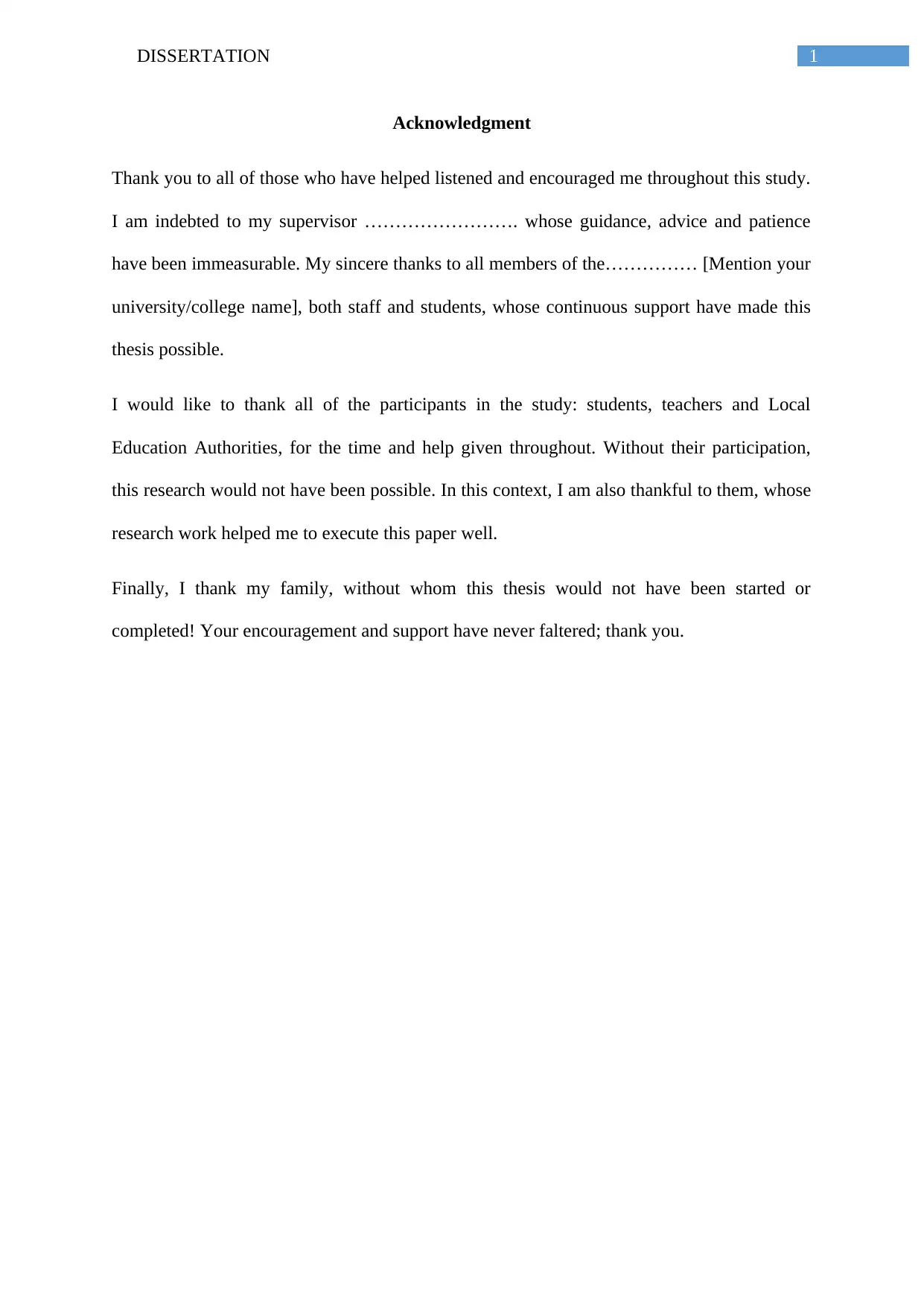
1DISSERTATION
Acknowledgment
Thank you to all of those who have helped listened and encouraged me throughout this study.
I am indebted to my supervisor ……………………. whose guidance, advice and patience
have been immeasurable. My sincere thanks to all members of the…………… [Mention your
university/college name], both staff and students, whose continuous support have made this
thesis possible.
I would like to thank all of the participants in the study: students, teachers and Local
Education Authorities, for the time and help given throughout. Without their participation,
this research would not have been possible. In this context, I am also thankful to them, whose
research work helped me to execute this paper well.
Finally, I thank my family, without whom this thesis would not have been started or
completed! Your encouragement and support have never faltered; thank you.
Acknowledgment
Thank you to all of those who have helped listened and encouraged me throughout this study.
I am indebted to my supervisor ……………………. whose guidance, advice and patience
have been immeasurable. My sincere thanks to all members of the…………… [Mention your
university/college name], both staff and students, whose continuous support have made this
thesis possible.
I would like to thank all of the participants in the study: students, teachers and Local
Education Authorities, for the time and help given throughout. Without their participation,
this research would not have been possible. In this context, I am also thankful to them, whose
research work helped me to execute this paper well.
Finally, I thank my family, without whom this thesis would not have been started or
completed! Your encouragement and support have never faltered; thank you.

2DISSERTATION
Abstract
Social media marketing is relatively a new type of marketing strategy that has
emerged over the past few years and has overtaken the traditional marketing strategy
significantly. Social media marketing is a rapidly growing form of marketing strategy around
the globe. The business organizations, regardless of the size are opting for social media
marketing techniques because of the various advantages it has to offer, both for the
companies and the consumers. The companies are able to reach the target audiences more
effectively that helps in influencing the behaviour of the consumers.
UK is a country of diversified population that signifies population with varied
consumer characteristics due to the individual nature. However, in spite of the consumer
diversity, the population of the country indicates considerable similarity in specific aspects
such as consumer behaviour. The relationship between social media marketing and consumer
behaviour is influenced by different factors such as technology, platforms used and the
purchase intentions of the consumers in the UK. All the three factors are found to the equally
significant when it comes to the impact on social media marketing. Technology has
facilitated the rise of social media marketing among the business organizations because with
it, both the parties are able to interact and communicate with each other smoothly. Similarly,
the platforms to be used also need to be selected accordingly because the platforms used have
to be preferred by the consumers. Hence, the consumers get better view of the products and
the services of the desired organization and increase sales and profit. Using the platforms
those are highly used and preferred by the target consumer’s influence the purchase
intentions of the customers accordingly.
In the conclusion, the three factors influencing social media marketing, as stated in
the above section, contributes largely towards the buying behaviour of the UK consumers.
Abstract
Social media marketing is relatively a new type of marketing strategy that has
emerged over the past few years and has overtaken the traditional marketing strategy
significantly. Social media marketing is a rapidly growing form of marketing strategy around
the globe. The business organizations, regardless of the size are opting for social media
marketing techniques because of the various advantages it has to offer, both for the
companies and the consumers. The companies are able to reach the target audiences more
effectively that helps in influencing the behaviour of the consumers.
UK is a country of diversified population that signifies population with varied
consumer characteristics due to the individual nature. However, in spite of the consumer
diversity, the population of the country indicates considerable similarity in specific aspects
such as consumer behaviour. The relationship between social media marketing and consumer
behaviour is influenced by different factors such as technology, platforms used and the
purchase intentions of the consumers in the UK. All the three factors are found to the equally
significant when it comes to the impact on social media marketing. Technology has
facilitated the rise of social media marketing among the business organizations because with
it, both the parties are able to interact and communicate with each other smoothly. Similarly,
the platforms to be used also need to be selected accordingly because the platforms used have
to be preferred by the consumers. Hence, the consumers get better view of the products and
the services of the desired organization and increase sales and profit. Using the platforms
those are highly used and preferred by the target consumer’s influence the purchase
intentions of the customers accordingly.
In the conclusion, the three factors influencing social media marketing, as stated in
the above section, contributes largely towards the buying behaviour of the UK consumers.
⊘ This is a preview!⊘
Do you want full access?
Subscribe today to unlock all pages.

Trusted by 1+ million students worldwide

3DISSERTATION
The business organizations need to consider these factors while selling to the consumers in
order to gain competitive advantage. Hence, the current research also shows the path for the
future researchers through suitable recommendations.
Keywords: Social media marketing, consumer behaviour, purchase intentions,
technology, platforms used
The business organizations need to consider these factors while selling to the consumers in
order to gain competitive advantage. Hence, the current research also shows the path for the
future researchers through suitable recommendations.
Keywords: Social media marketing, consumer behaviour, purchase intentions,
technology, platforms used
Paraphrase This Document
Need a fresh take? Get an instant paraphrase of this document with our AI Paraphraser
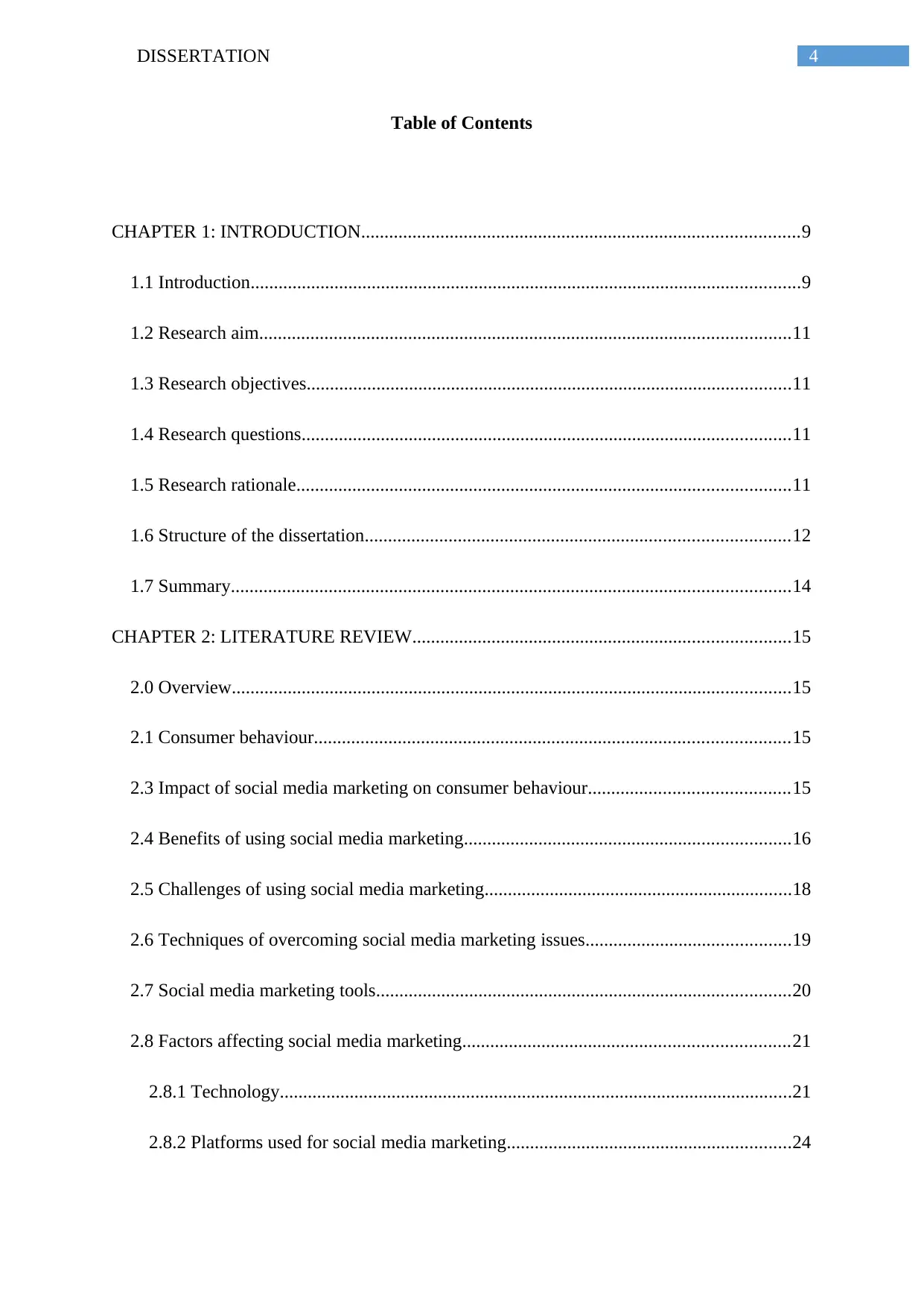
4DISSERTATION
Table of Contents
CHAPTER 1: INTRODUCTION..............................................................................................9
1.1 Introduction......................................................................................................................9
1.2 Research aim..................................................................................................................11
1.3 Research objectives........................................................................................................11
1.4 Research questions.........................................................................................................11
1.5 Research rationale..........................................................................................................11
1.6 Structure of the dissertation...........................................................................................12
1.7 Summary........................................................................................................................14
CHAPTER 2: LITERATURE REVIEW.................................................................................15
2.0 Overview........................................................................................................................15
2.1 Consumer behaviour......................................................................................................15
2.3 Impact of social media marketing on consumer behaviour...........................................15
2.4 Benefits of using social media marketing......................................................................16
2.5 Challenges of using social media marketing..................................................................18
2.6 Techniques of overcoming social media marketing issues............................................19
2.7 Social media marketing tools.........................................................................................20
2.8 Factors affecting social media marketing......................................................................21
2.8.1 Technology..............................................................................................................21
2.8.2 Platforms used for social media marketing.............................................................24
Table of Contents
CHAPTER 1: INTRODUCTION..............................................................................................9
1.1 Introduction......................................................................................................................9
1.2 Research aim..................................................................................................................11
1.3 Research objectives........................................................................................................11
1.4 Research questions.........................................................................................................11
1.5 Research rationale..........................................................................................................11
1.6 Structure of the dissertation...........................................................................................12
1.7 Summary........................................................................................................................14
CHAPTER 2: LITERATURE REVIEW.................................................................................15
2.0 Overview........................................................................................................................15
2.1 Consumer behaviour......................................................................................................15
2.3 Impact of social media marketing on consumer behaviour...........................................15
2.4 Benefits of using social media marketing......................................................................16
2.5 Challenges of using social media marketing..................................................................18
2.6 Techniques of overcoming social media marketing issues............................................19
2.7 Social media marketing tools.........................................................................................20
2.8 Factors affecting social media marketing......................................................................21
2.8.1 Technology..............................................................................................................21
2.8.2 Platforms used for social media marketing.............................................................24
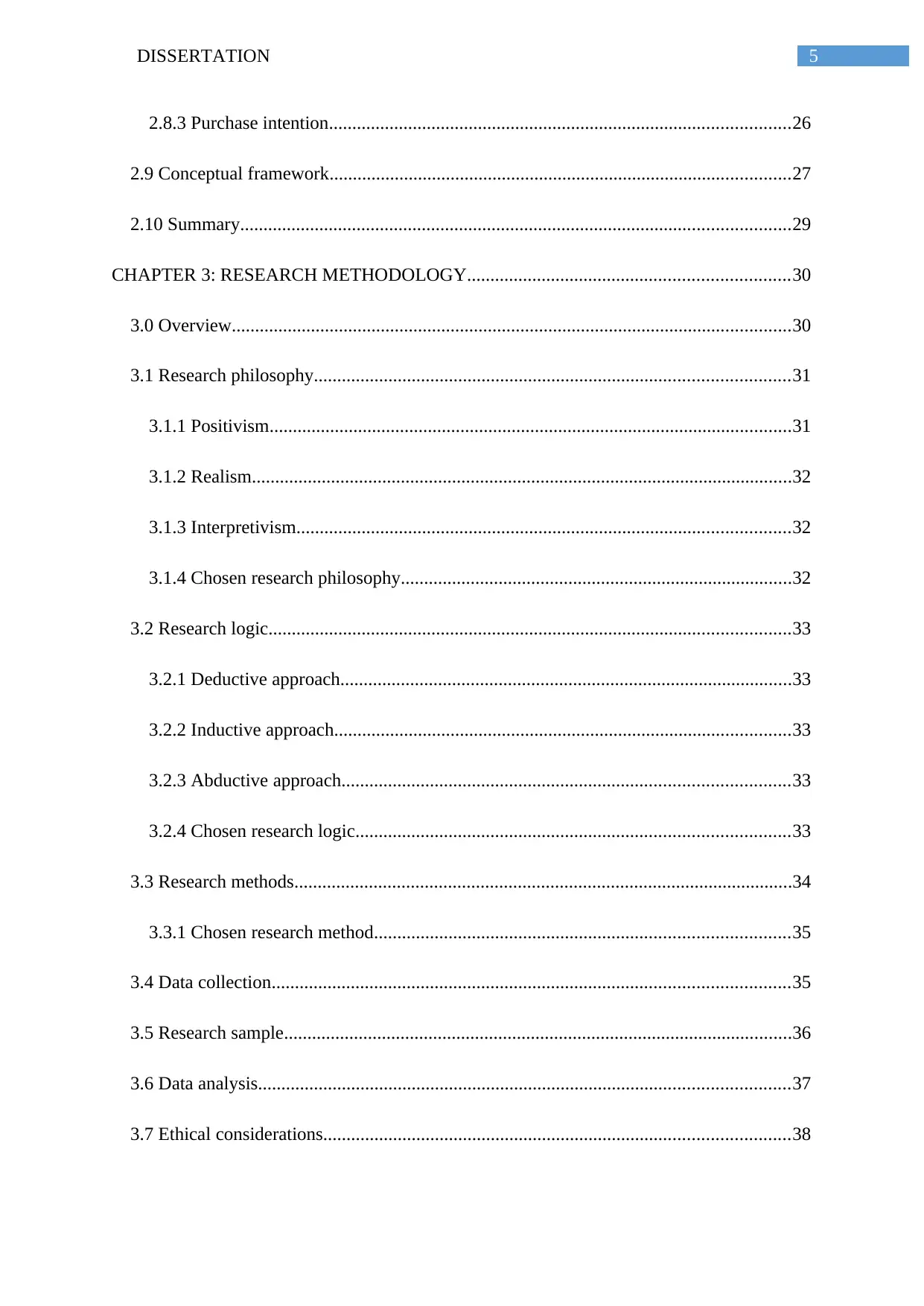
5DISSERTATION
2.8.3 Purchase intention...................................................................................................26
2.9 Conceptual framework...................................................................................................27
2.10 Summary......................................................................................................................29
CHAPTER 3: RESEARCH METHODOLOGY.....................................................................30
3.0 Overview........................................................................................................................30
3.1 Research philosophy......................................................................................................31
3.1.1 Positivism................................................................................................................31
3.1.2 Realism....................................................................................................................32
3.1.3 Interpretivism..........................................................................................................32
3.1.4 Chosen research philosophy....................................................................................32
3.2 Research logic................................................................................................................33
3.2.1 Deductive approach.................................................................................................33
3.2.2 Inductive approach..................................................................................................33
3.2.3 Abductive approach................................................................................................33
3.2.4 Chosen research logic.............................................................................................33
3.3 Research methods...........................................................................................................34
3.3.1 Chosen research method.........................................................................................35
3.4 Data collection...............................................................................................................35
3.5 Research sample.............................................................................................................36
3.6 Data analysis..................................................................................................................37
3.7 Ethical considerations....................................................................................................38
2.8.3 Purchase intention...................................................................................................26
2.9 Conceptual framework...................................................................................................27
2.10 Summary......................................................................................................................29
CHAPTER 3: RESEARCH METHODOLOGY.....................................................................30
3.0 Overview........................................................................................................................30
3.1 Research philosophy......................................................................................................31
3.1.1 Positivism................................................................................................................31
3.1.2 Realism....................................................................................................................32
3.1.3 Interpretivism..........................................................................................................32
3.1.4 Chosen research philosophy....................................................................................32
3.2 Research logic................................................................................................................33
3.2.1 Deductive approach.................................................................................................33
3.2.2 Inductive approach..................................................................................................33
3.2.3 Abductive approach................................................................................................33
3.2.4 Chosen research logic.............................................................................................33
3.3 Research methods...........................................................................................................34
3.3.1 Chosen research method.........................................................................................35
3.4 Data collection...............................................................................................................35
3.5 Research sample.............................................................................................................36
3.6 Data analysis..................................................................................................................37
3.7 Ethical considerations....................................................................................................38
⊘ This is a preview!⊘
Do you want full access?
Subscribe today to unlock all pages.

Trusted by 1+ million students worldwide
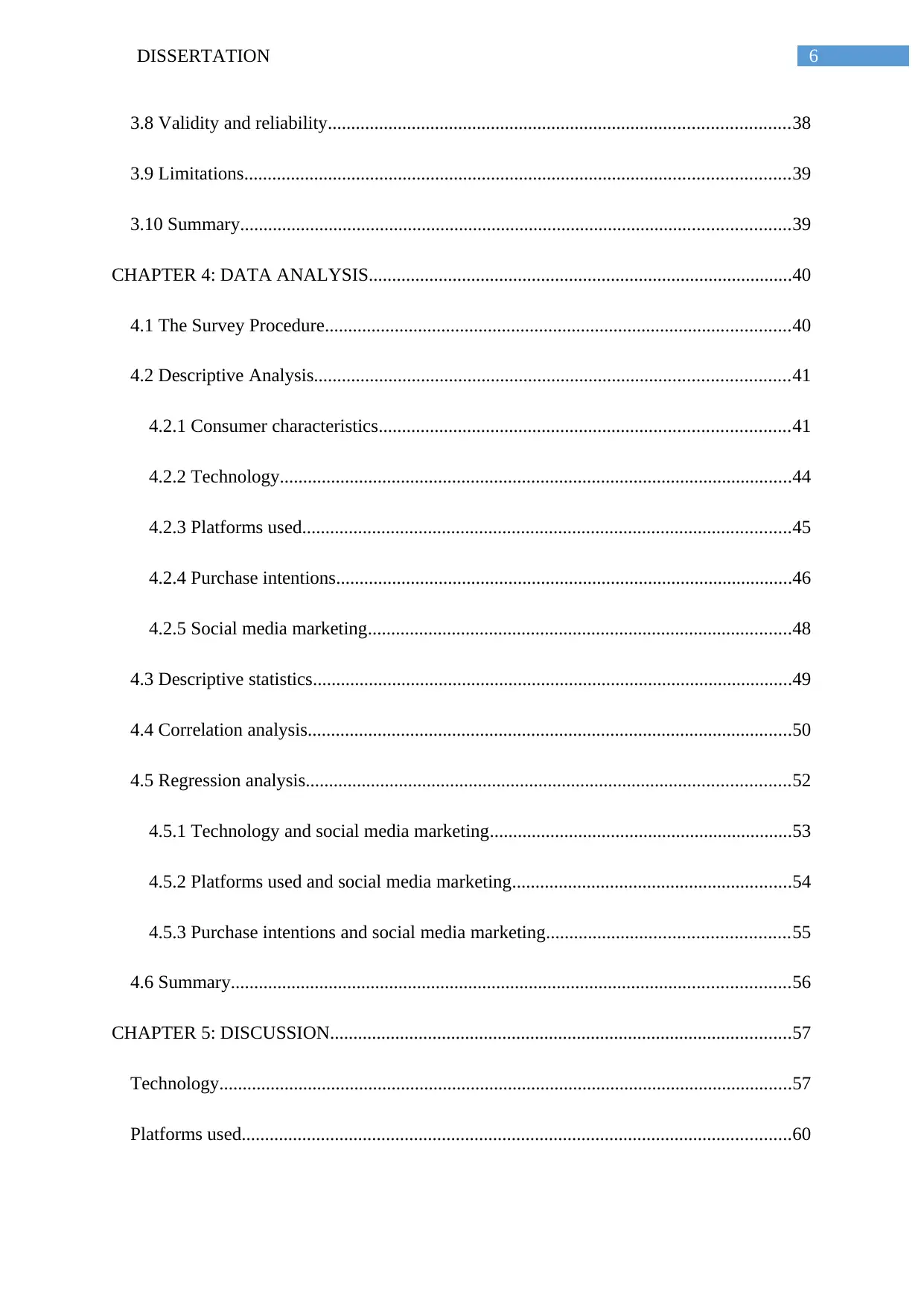
6DISSERTATION
3.8 Validity and reliability...................................................................................................38
3.9 Limitations.....................................................................................................................39
3.10 Summary......................................................................................................................39
CHAPTER 4: DATA ANALYSIS...........................................................................................40
4.1 The Survey Procedure....................................................................................................40
4.2 Descriptive Analysis......................................................................................................41
4.2.1 Consumer characteristics........................................................................................41
4.2.2 Technology..............................................................................................................44
4.2.3 Platforms used.........................................................................................................45
4.2.4 Purchase intentions..................................................................................................46
4.2.5 Social media marketing...........................................................................................48
4.3 Descriptive statistics.......................................................................................................49
4.4 Correlation analysis........................................................................................................50
4.5 Regression analysis........................................................................................................52
4.5.1 Technology and social media marketing.................................................................53
4.5.2 Platforms used and social media marketing............................................................54
4.5.3 Purchase intentions and social media marketing....................................................55
4.6 Summary........................................................................................................................56
CHAPTER 5: DISCUSSION...................................................................................................57
Technology...........................................................................................................................57
Platforms used......................................................................................................................60
3.8 Validity and reliability...................................................................................................38
3.9 Limitations.....................................................................................................................39
3.10 Summary......................................................................................................................39
CHAPTER 4: DATA ANALYSIS...........................................................................................40
4.1 The Survey Procedure....................................................................................................40
4.2 Descriptive Analysis......................................................................................................41
4.2.1 Consumer characteristics........................................................................................41
4.2.2 Technology..............................................................................................................44
4.2.3 Platforms used.........................................................................................................45
4.2.4 Purchase intentions..................................................................................................46
4.2.5 Social media marketing...........................................................................................48
4.3 Descriptive statistics.......................................................................................................49
4.4 Correlation analysis........................................................................................................50
4.5 Regression analysis........................................................................................................52
4.5.1 Technology and social media marketing.................................................................53
4.5.2 Platforms used and social media marketing............................................................54
4.5.3 Purchase intentions and social media marketing....................................................55
4.6 Summary........................................................................................................................56
CHAPTER 5: DISCUSSION...................................................................................................57
Technology...........................................................................................................................57
Platforms used......................................................................................................................60
Paraphrase This Document
Need a fresh take? Get an instant paraphrase of this document with our AI Paraphraser
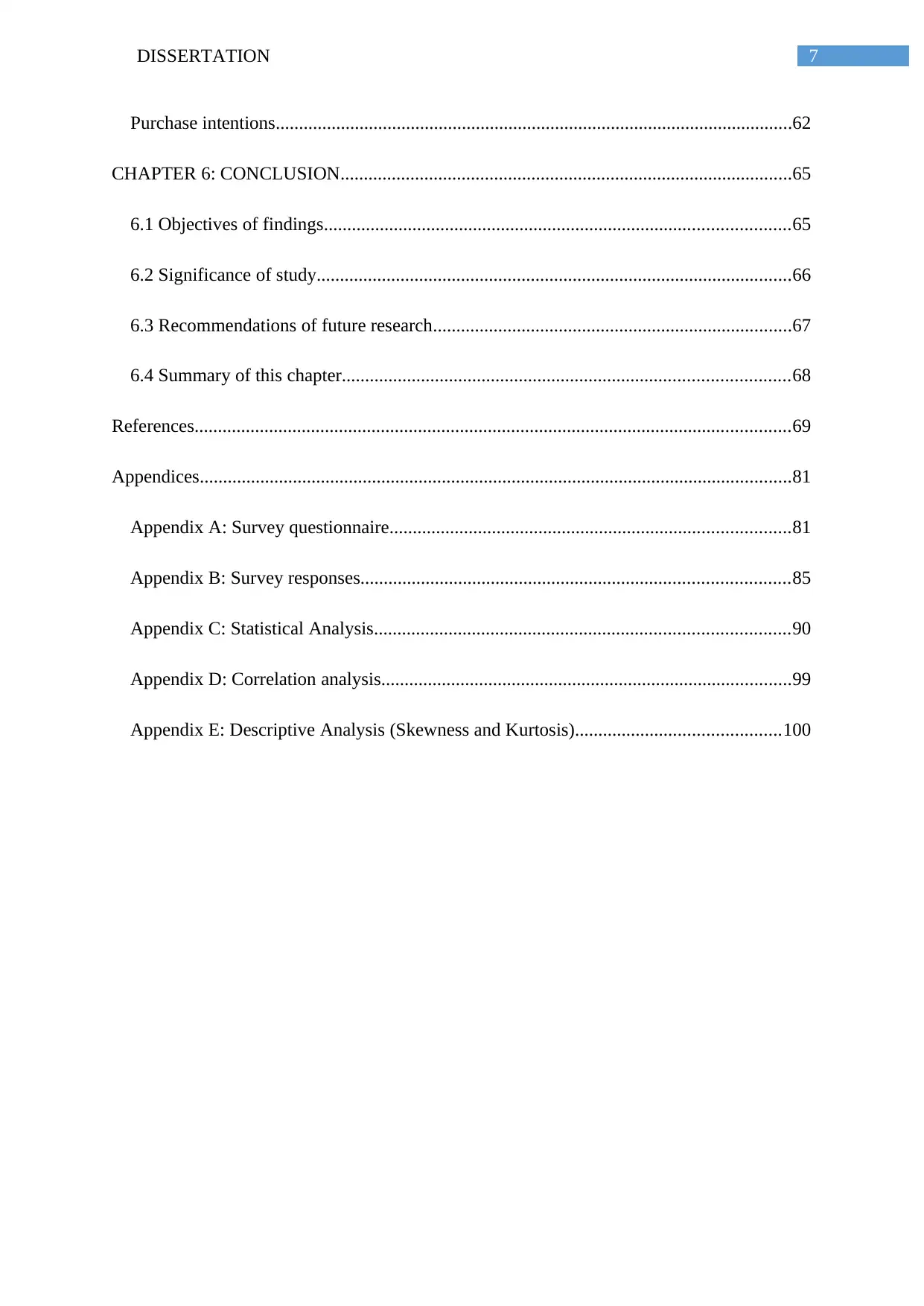
7DISSERTATION
Purchase intentions...............................................................................................................62
CHAPTER 6: CONCLUSION.................................................................................................65
6.1 Objectives of findings....................................................................................................65
6.2 Significance of study......................................................................................................66
6.3 Recommendations of future research.............................................................................67
6.4 Summary of this chapter................................................................................................68
References................................................................................................................................69
Appendices...............................................................................................................................81
Appendix A: Survey questionnaire......................................................................................81
Appendix B: Survey responses............................................................................................85
Appendix C: Statistical Analysis.........................................................................................90
Appendix D: Correlation analysis........................................................................................99
Appendix E: Descriptive Analysis (Skewness and Kurtosis)............................................100
Purchase intentions...............................................................................................................62
CHAPTER 6: CONCLUSION.................................................................................................65
6.1 Objectives of findings....................................................................................................65
6.2 Significance of study......................................................................................................66
6.3 Recommendations of future research.............................................................................67
6.4 Summary of this chapter................................................................................................68
References................................................................................................................................69
Appendices...............................................................................................................................81
Appendix A: Survey questionnaire......................................................................................81
Appendix B: Survey responses............................................................................................85
Appendix C: Statistical Analysis.........................................................................................90
Appendix D: Correlation analysis........................................................................................99
Appendix E: Descriptive Analysis (Skewness and Kurtosis)............................................100
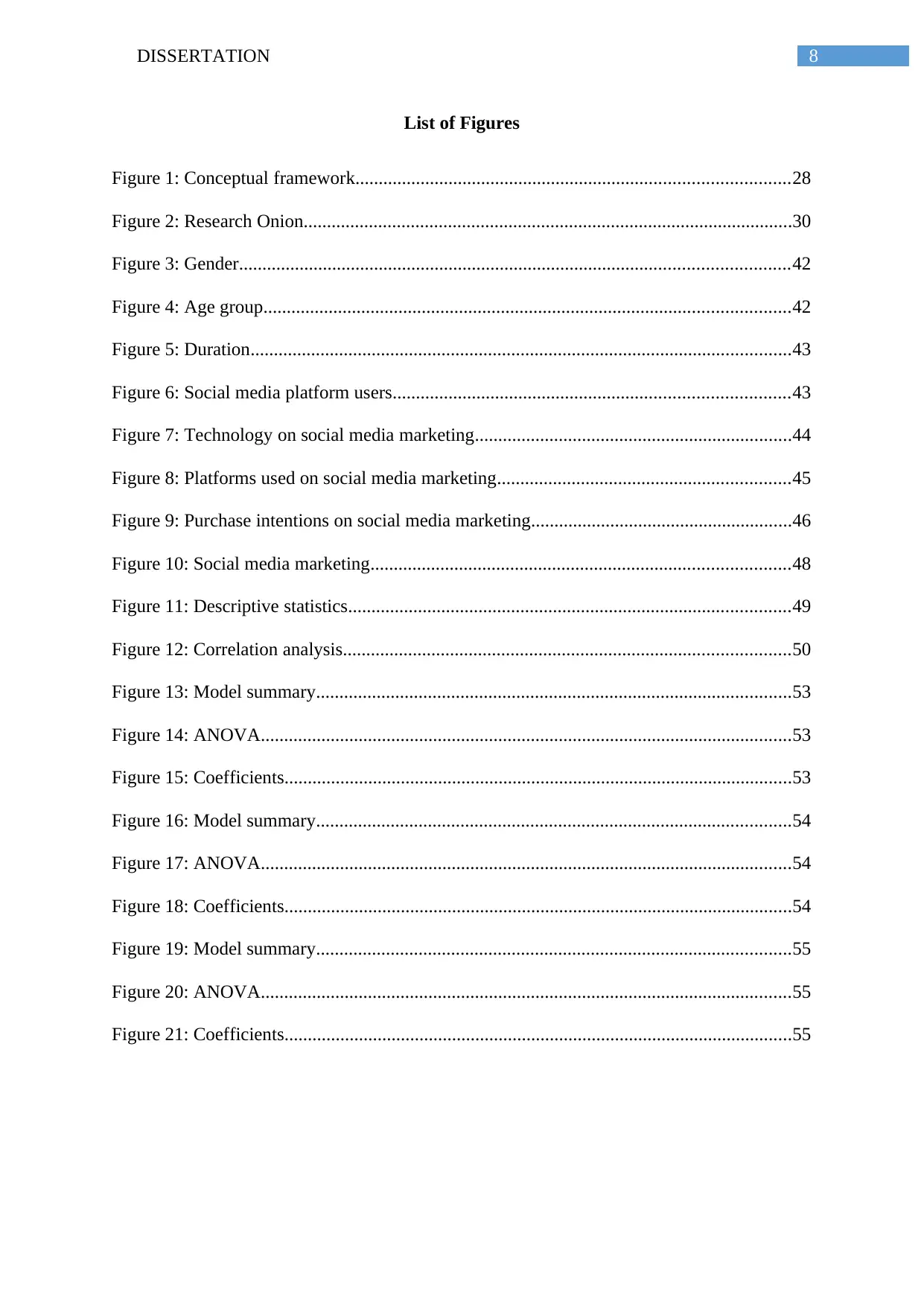
8DISSERTATION
List of Figures
Figure 1: Conceptual framework.............................................................................................28
Figure 2: Research Onion.........................................................................................................30
Figure 3: Gender......................................................................................................................42
Figure 4: Age group.................................................................................................................42
Figure 5: Duration....................................................................................................................43
Figure 6: Social media platform users.....................................................................................43
Figure 7: Technology on social media marketing....................................................................44
Figure 8: Platforms used on social media marketing...............................................................45
Figure 9: Purchase intentions on social media marketing........................................................46
Figure 10: Social media marketing..........................................................................................48
Figure 11: Descriptive statistics...............................................................................................49
Figure 12: Correlation analysis................................................................................................50
Figure 13: Model summary......................................................................................................53
Figure 14: ANOVA..................................................................................................................53
Figure 15: Coefficients.............................................................................................................53
Figure 16: Model summary......................................................................................................54
Figure 17: ANOVA..................................................................................................................54
Figure 18: Coefficients.............................................................................................................54
Figure 19: Model summary......................................................................................................55
Figure 20: ANOVA..................................................................................................................55
Figure 21: Coefficients.............................................................................................................55
List of Figures
Figure 1: Conceptual framework.............................................................................................28
Figure 2: Research Onion.........................................................................................................30
Figure 3: Gender......................................................................................................................42
Figure 4: Age group.................................................................................................................42
Figure 5: Duration....................................................................................................................43
Figure 6: Social media platform users.....................................................................................43
Figure 7: Technology on social media marketing....................................................................44
Figure 8: Platforms used on social media marketing...............................................................45
Figure 9: Purchase intentions on social media marketing........................................................46
Figure 10: Social media marketing..........................................................................................48
Figure 11: Descriptive statistics...............................................................................................49
Figure 12: Correlation analysis................................................................................................50
Figure 13: Model summary......................................................................................................53
Figure 14: ANOVA..................................................................................................................53
Figure 15: Coefficients.............................................................................................................53
Figure 16: Model summary......................................................................................................54
Figure 17: ANOVA..................................................................................................................54
Figure 18: Coefficients.............................................................................................................54
Figure 19: Model summary......................................................................................................55
Figure 20: ANOVA..................................................................................................................55
Figure 21: Coefficients.............................................................................................................55
⊘ This is a preview!⊘
Do you want full access?
Subscribe today to unlock all pages.

Trusted by 1+ million students worldwide

9DISSERTATION
CHAPTER 1: INTRODUCTION
1.1 Introduction
In the modern world, the role of technology and digitalization is noticed in every aspects
of life. As mentioned by Ryan (2016), the offline and online worlds are colliding and even
the traditional devices such as billboards are modernized for leveraging social media. The
competition in the business world has increased manifolds due to the rise of similar types of
business organizations that is resulting in market saturation. With the rise of technology,
social media marked its presence and traditional marketing started getting obsolete because it
failed to provide the benefits and opportunities in terms of sales and business growth to the
organizations. With social media marketing, business organizations are able to target
consumers across the world without being present physically.
The world population is just a fingertip away when it comes to social media marketing
because in today’s world majority of the population are active in different social media
platforms. This makes it easy for the business organizations influences consumers without
any restrictions in terms of location or time (Stephen 2016). With social media marketing,
business organization can post the ads throughout the day on their official social media pages
that helps in creating positive influence on the consumer behaviour. Hence, with constant
featuring, the consumers are imitated by it and respond to it accordingly.
Studying the behaviour of the consumers is necessary because it provides opportunity to
the business organizations to know the taste and preference of the consumers. Once known
the needs and preferences in terms of products, the business organizations can design and
develop products accordingly and launch it in the market. When the consumers see that the
business organizations has been constant in fulfilling their needs and behaviour, they feel
influenced that lead to positive results in terms of sales, revenue and competitive advantage
CHAPTER 1: INTRODUCTION
1.1 Introduction
In the modern world, the role of technology and digitalization is noticed in every aspects
of life. As mentioned by Ryan (2016), the offline and online worlds are colliding and even
the traditional devices such as billboards are modernized for leveraging social media. The
competition in the business world has increased manifolds due to the rise of similar types of
business organizations that is resulting in market saturation. With the rise of technology,
social media marked its presence and traditional marketing started getting obsolete because it
failed to provide the benefits and opportunities in terms of sales and business growth to the
organizations. With social media marketing, business organizations are able to target
consumers across the world without being present physically.
The world population is just a fingertip away when it comes to social media marketing
because in today’s world majority of the population are active in different social media
platforms. This makes it easy for the business organizations influences consumers without
any restrictions in terms of location or time (Stephen 2016). With social media marketing,
business organization can post the ads throughout the day on their official social media pages
that helps in creating positive influence on the consumer behaviour. Hence, with constant
featuring, the consumers are imitated by it and respond to it accordingly.
Studying the behaviour of the consumers is necessary because it provides opportunity to
the business organizations to know the taste and preference of the consumers. Once known
the needs and preferences in terms of products, the business organizations can design and
develop products accordingly and launch it in the market. When the consumers see that the
business organizations has been constant in fulfilling their needs and behaviour, they feel
influenced that lead to positive results in terms of sales, revenue and competitive advantage
Paraphrase This Document
Need a fresh take? Get an instant paraphrase of this document with our AI Paraphraser
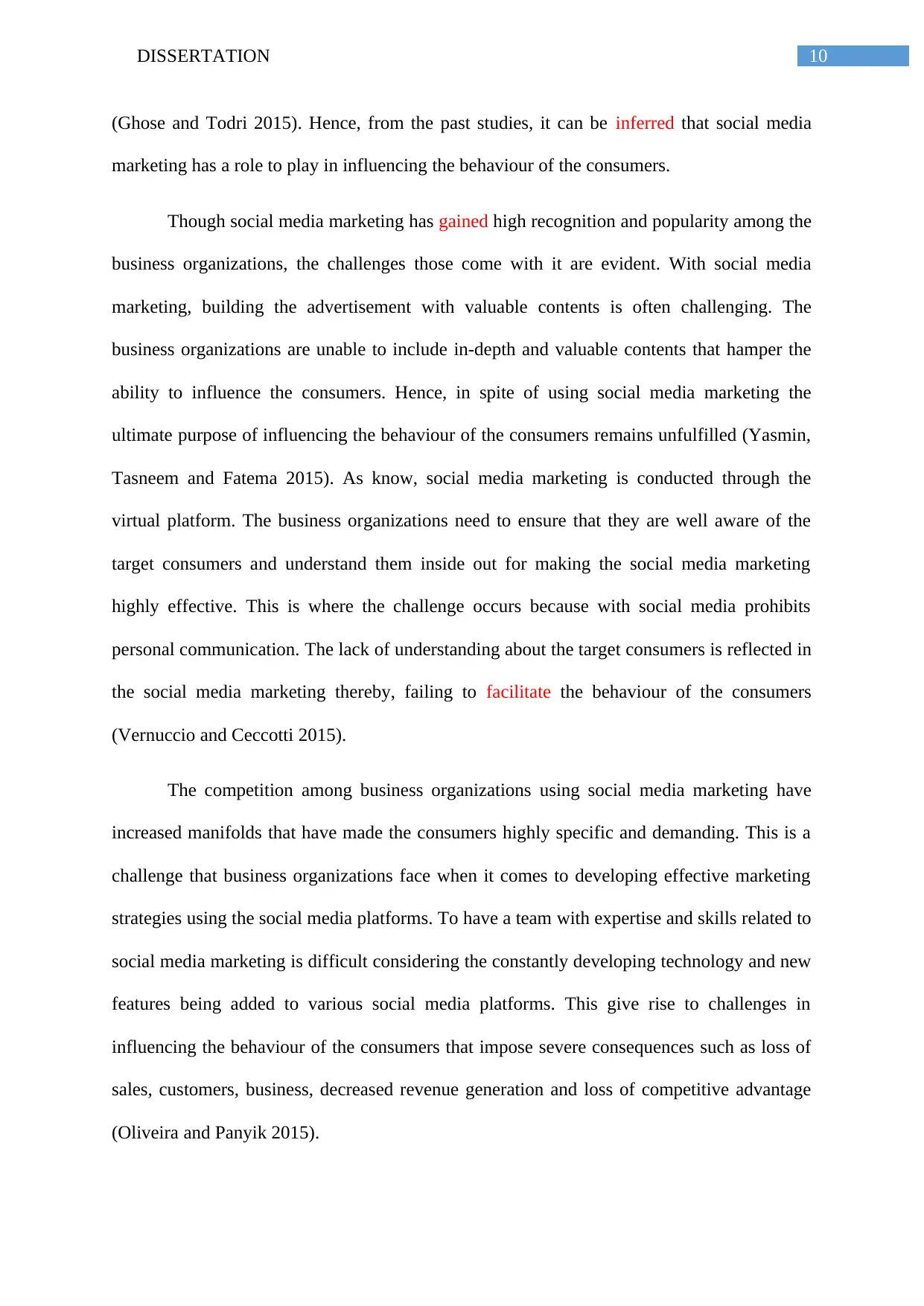
10DISSERTATION
(Ghose and Todri 2015). Hence, from the past studies, it can be inferred that social media
marketing has a role to play in influencing the behaviour of the consumers.
Though social media marketing has gained high recognition and popularity among the
business organizations, the challenges those come with it are evident. With social media
marketing, building the advertisement with valuable contents is often challenging. The
business organizations are unable to include in-depth and valuable contents that hamper the
ability to influence the consumers. Hence, in spite of using social media marketing the
ultimate purpose of influencing the behaviour of the consumers remains unfulfilled (Yasmin,
Tasneem and Fatema 2015). As know, social media marketing is conducted through the
virtual platform. The business organizations need to ensure that they are well aware of the
target consumers and understand them inside out for making the social media marketing
highly effective. This is where the challenge occurs because with social media prohibits
personal communication. The lack of understanding about the target consumers is reflected in
the social media marketing thereby, failing to facilitate the behaviour of the consumers
(Vernuccio and Ceccotti 2015).
The competition among business organizations using social media marketing have
increased manifolds that have made the consumers highly specific and demanding. This is a
challenge that business organizations face when it comes to developing effective marketing
strategies using the social media platforms. To have a team with expertise and skills related to
social media marketing is difficult considering the constantly developing technology and new
features being added to various social media platforms. This give rise to challenges in
influencing the behaviour of the consumers that impose severe consequences such as loss of
sales, customers, business, decreased revenue generation and loss of competitive advantage
(Oliveira and Panyik 2015).
(Ghose and Todri 2015). Hence, from the past studies, it can be inferred that social media
marketing has a role to play in influencing the behaviour of the consumers.
Though social media marketing has gained high recognition and popularity among the
business organizations, the challenges those come with it are evident. With social media
marketing, building the advertisement with valuable contents is often challenging. The
business organizations are unable to include in-depth and valuable contents that hamper the
ability to influence the consumers. Hence, in spite of using social media marketing the
ultimate purpose of influencing the behaviour of the consumers remains unfulfilled (Yasmin,
Tasneem and Fatema 2015). As know, social media marketing is conducted through the
virtual platform. The business organizations need to ensure that they are well aware of the
target consumers and understand them inside out for making the social media marketing
highly effective. This is where the challenge occurs because with social media prohibits
personal communication. The lack of understanding about the target consumers is reflected in
the social media marketing thereby, failing to facilitate the behaviour of the consumers
(Vernuccio and Ceccotti 2015).
The competition among business organizations using social media marketing have
increased manifolds that have made the consumers highly specific and demanding. This is a
challenge that business organizations face when it comes to developing effective marketing
strategies using the social media platforms. To have a team with expertise and skills related to
social media marketing is difficult considering the constantly developing technology and new
features being added to various social media platforms. This give rise to challenges in
influencing the behaviour of the consumers that impose severe consequences such as loss of
sales, customers, business, decreased revenue generation and loss of competitive advantage
(Oliveira and Panyik 2015).
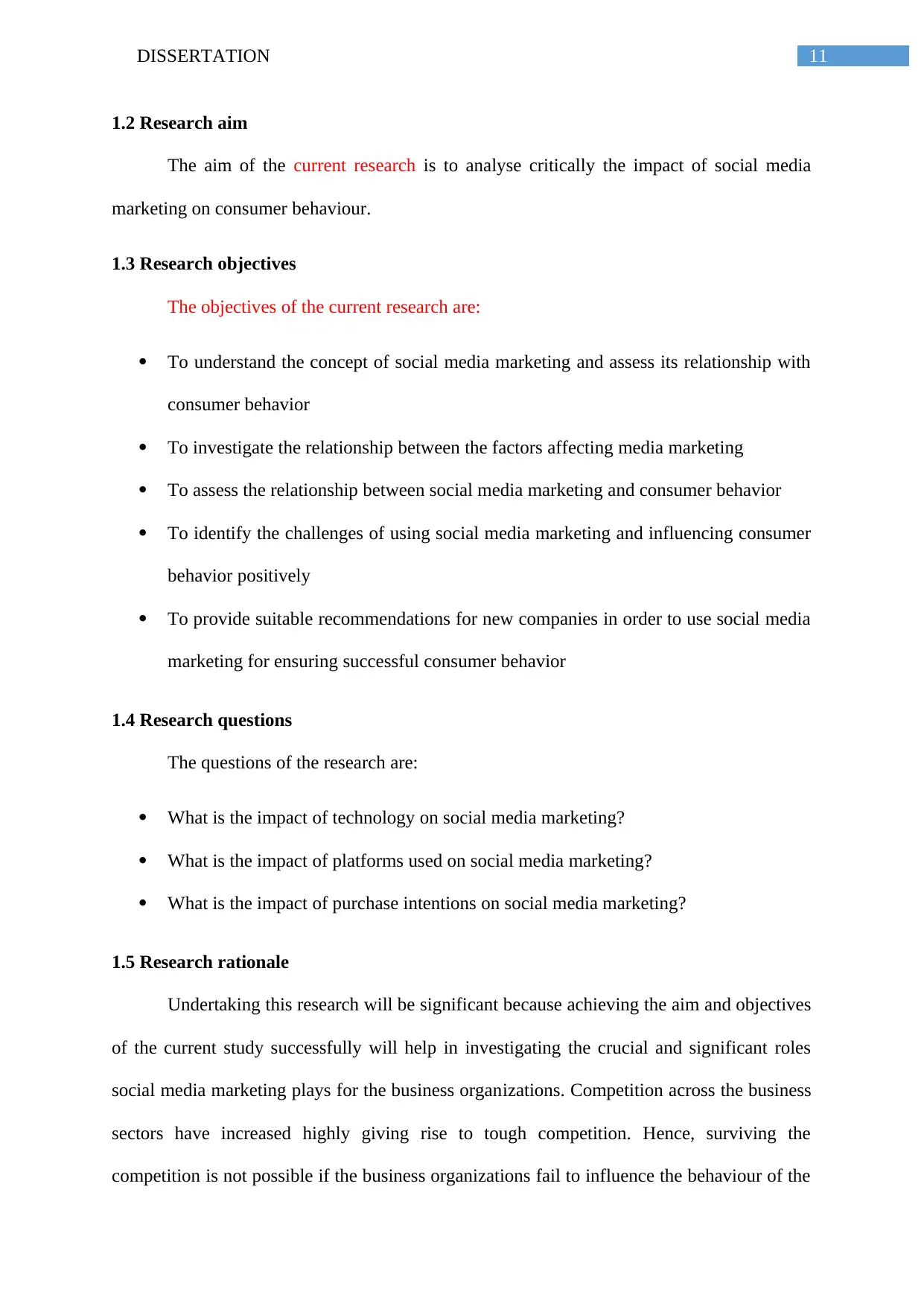
11DISSERTATION
1.2 Research aim
The aim of the current research is to analyse critically the impact of social media
marketing on consumer behaviour.
1.3 Research objectives
The objectives of the current research are:
To understand the concept of social media marketing and assess its relationship with
consumer behavior
To investigate the relationship between the factors affecting media marketing
To assess the relationship between social media marketing and consumer behavior
To identify the challenges of using social media marketing and influencing consumer
behavior positively
To provide suitable recommendations for new companies in order to use social media
marketing for ensuring successful consumer behavior
1.4 Research questions
The questions of the research are:
What is the impact of technology on social media marketing?
What is the impact of platforms used on social media marketing?
What is the impact of purchase intentions on social media marketing?
1.5 Research rationale
Undertaking this research will be significant because achieving the aim and objectives
of the current study successfully will help in investigating the crucial and significant roles
social media marketing plays for the business organizations. Competition across the business
sectors have increased highly giving rise to tough competition. Hence, surviving the
competition is not possible if the business organizations fail to influence the behaviour of the
1.2 Research aim
The aim of the current research is to analyse critically the impact of social media
marketing on consumer behaviour.
1.3 Research objectives
The objectives of the current research are:
To understand the concept of social media marketing and assess its relationship with
consumer behavior
To investigate the relationship between the factors affecting media marketing
To assess the relationship between social media marketing and consumer behavior
To identify the challenges of using social media marketing and influencing consumer
behavior positively
To provide suitable recommendations for new companies in order to use social media
marketing for ensuring successful consumer behavior
1.4 Research questions
The questions of the research are:
What is the impact of technology on social media marketing?
What is the impact of platforms used on social media marketing?
What is the impact of purchase intentions on social media marketing?
1.5 Research rationale
Undertaking this research will be significant because achieving the aim and objectives
of the current study successfully will help in investigating the crucial and significant roles
social media marketing plays for the business organizations. Competition across the business
sectors have increased highly giving rise to tough competition. Hence, surviving the
competition is not possible if the business organizations fail to influence the behaviour of the
⊘ This is a preview!⊘
Do you want full access?
Subscribe today to unlock all pages.

Trusted by 1+ million students worldwide
1 out of 105
Related Documents
Your All-in-One AI-Powered Toolkit for Academic Success.
+13062052269
info@desklib.com
Available 24*7 on WhatsApp / Email
![[object Object]](/_next/static/media/star-bottom.7253800d.svg)
Unlock your academic potential
Copyright © 2020–2025 A2Z Services. All Rights Reserved. Developed and managed by ZUCOL.




